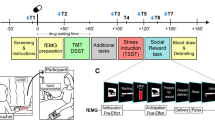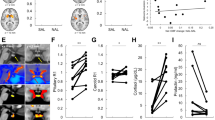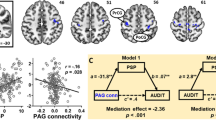Abstract
The endogenous opioid system, which alleviates physical pain, is also known to regulate social distress and reward in animal models. To test this hypothesis in humans (n=18), we used an μ-opioid receptor (MOR) radiotracer to measure changes in MOR availability in vivo with positron emission tomography during social rejection (not being liked by others) and acceptance (being liked by others). Social rejection significantly activated the MOR system (i.e., reduced receptor availability relative to baseline) in the ventral striatum, amygdala, midline thalamus and periaqueductal gray (PAG). This pattern of activation is consistent with the hypothesis that the endogenous opioids have a role in reducing the experience of social pain. Greater trait resiliency was positively correlated with MOR activation during rejection in the amygdala, PAG and subgenual anterior cingulate cortex (sgACC), suggesting that MOR activation in these areas is protective or adaptive. In addition, MOR activation in the pregenual ACC was correlated with reduced negative affect during rejection. In contrast, social acceptance resulted in MOR activation in the amygdala and anterior insula, and MOR deactivation in the midline thalamus and sgACC. In the left ventral striatum, MOR activation during acceptance predicted a greater desire for social interaction, suggesting a role for the MOR system in social reward. The ventral striatum, amygdala, midline thalamus, PAG, anterior insula and ACC are rich in MORs and comprise a pathway by which social cues may influence mood and motivation. MOR regulation of this pathway may preserve and promote emotional well being in the social environment.
This is a preview of subscription content, access via your institution
Access options
Subscribe to this journal
Receive 12 print issues and online access
$259.00 per year
only $21.58 per issue
Buy this article
- Purchase on Springer Link
- Instant access to full article PDF
Prices may be subject to local taxes which are calculated during checkout



Similar content being viewed by others
References
Baumeister RF, DeWall CN, Ciarocco NJ, Twenge JM . Social exclusion impairs self-regulation. J Pers Soc Psychol 2005; 88: 589–604.
Williams KD . Ostracism. Annu Rev Psychol 2007; 58: 425–452.
Mallott MA, Maner JK, DeWall N, Schmidt NB . Compensatory deficits following rejection: the role of social anxiety in disrupting affiliative behavior. Depress Anxiety 2009; 26: 438–446.
Slavich GM, O’Donovan A, Epel ES, Kemeny ME . Black sheep get the blues: a psychobiological model of social rejection and depression. Neurosci Biobehav Rev 2010; 35: 39–45.
Eisenberger NI, Lieberman MD, Williams KD . Does rejection hurt? An FMRI study of social exclusion. Science 2003; 302: 290–292.
Ehnvall A, Mitchell PB, Hadzi-Pavlovic D, Malhi GS, Parker G . Pain during depression and relationship to rejection sensitivity. Acta Psychiatr Scand 2009; 119: 375–382.
MacDonald G, Jensen-Campbell LA (eds). Social Pain: Neuropsychology and Health Implications of Loss and Exclusion 1st edn. American Psychological Association (APA), 2011 p 264.
Kross E, Berman MG, Mischel W, Smith EE, Wager TD . Social rejection shares somatosensory representations with physical pain. Proc Natl Acad Sci USA 2011; 108: 6270–6275.
Eisenberger NI . The pain of social disconnection: examining the shared neural underpinnings of physical and social pain. Nat Rev Neurosci 2012; 13: 421–434.
Panksepp J, Herman B, Conner R, Bishop P, Scott JP . The biology of social attachments: opiates alleviate separation distress. Biol Psychiatry 1978; 13: 607–618.
Panksepp J, Herman BH, Vilberg T, Bishop P, DeEskinazi FG . Endogenous opioids and social behavior. Neurosci Biobehav Rev 1980; 4: 473–487.
Herman BH, Panksepp J . Ascending endorphin inhibition of distress vocalization. Science 1981; 211: 1060–1062.
Kalin NH, Shelton SE, Barksdale CM . Opiate modulation of separation-induced distress in non-human primates. Brain Res 1988; 440: 285–292.
Kalin NH, Shelton SE, Lynn DE . Opiate systems in mother and infant primates coordinate intimate contact during reunion. Psychoneuroendocrinology 1995; 20: 735–742.
Dewall CN, Macdonald G, Webster GD, Masten CL, Baumeister RF, Powell C et al. Acetaminophen reduces social pain: behavioral and neural evidence. Psychol Sci 2010; 21: 931–937.
Way BM, Taylor SE, Eisenberger NI . Variation in the mu–opioid receptor gene (OPRM1) is associated with dispositional and neural sensitivity to social rejection. Proc Natl Acad Sci USA 2009; 106: 15079–15084.
Siegel MA, Jensen RA, Panksepp J . The prolonged effects of naloxone on play behavior and feeding in the rat. Behav Neural Biol 1985; 44: 509–514.
Vanderschuren LJ, Niesink RJ, Spruijt BM, Van Ree JM . Mu- and kappa-opioid receptor-mediated opioid effects on social play in juvenile rats. Eur J Pharmacol 1995; 276: 257–266.
Trezza V, Baarendse PJJ, Vanderschuren LJMJ . The pleasures of play: pharmacological insights into social reward mechanisms. Trends Pharmacol Sci 2010; 31: 463–469.
Trezza V, Damsteegt R, Achterberg EJM, Vanderschuren LJMJ . Nucleus accumbens μ-opioid receptors mediate social reward. J Neurosci 2011; 31: 6362–6370.
Titeler M, Lyon RA, Kuhar MJ, Frost JF, Dannals RF, Leonhardt S et al. Mu opiate receptors are selectively labelled by [3H]carfentanil in human and rat brain. Eur J Pharmacol 1989; 167: 221–228.
Smith YR, Zubieta JK, del Carmen MG, Dannals RF, Ravert HT, Zacur HA et al. Brain opioid receptor measurements by positron emission tomography in normal cycling women: relationship to luteinizing hormone pulsatility and gonadal steroid hormones. J Clin Endocrinol Metab 1998; 83: 4498–4505.
Block J . The Challenge of Response Sets: Unconfounding Meaning, Acquiesence, and Social Desirability in the MMPI. Appleton-Century-Crofts, 1965 p 168.
Somerville LH, Heatherton TF, Kelley WM . Anterior cingulate cortex responds differentially to expectancy violation and social rejection. Nat Neurosci 2006; 9: 1007–1008.
Davey CG, Allen NB, Harrison BJ, Dwyer DB, Yücel M . Being liked activates primary reward and midline self-related brain regions. Hum Brain Mapp 2010; 31: 660–668.
Zubieta JK, Smith YR, Bueller JA, Xu Y, Kilbourn MR, Jewett DM et al. Regional mu opioid receptor regulation of sensory and affective dimensions of pain. Science 2001; 293: 311–315.
Zubieta J-K, Ketter TA, Bueller JA, Xu Y, Kilbourn MR, Young EA et al. Regulation of human affective responses by anterior cingulate and limbic mu-opioid neurotransmission. Arch Gen Psychiatry 2003; 60: 1145–1153.
Worsley KJ, Evans AC, Marrett S, Neelin P . A three-dimensional statistical analysis for CBF activation studies in human brain. J Cereb Blood Flow Metab 1992; 12: 900–918.
Tzourio-Mazoyer N, Landeau B, Papathanassiou D, Crivello F, Etard O, Delcroix N et al. Automated anatomical labeling of activations in SPM using a macroscopic anatomical parcellation of the MNI MRI single-subject brain. NeuroImage 2002; 15: 273–289.
Maldjian JA, Laurienti PJ, Kraft RA, Burdette JH . An automated method for neuroanatomic and cytoarchitectonic atlas-based interrogation of fMRI data sets. NeuroImage 2003; 19: 1233–1239.
Delfs JM, Kong H, Mestek A, Chen Y, Yu L, Reisine T et al. Expression of mu opioid receptor mRNA in rat brain: an in situ hybridization study at the single cell level. J Comp Neurol 1994; 345: 46–68.
Mansour A, Fox CA, Thompson RC, Akil H, Watson SJ . Mu-opioid receptor mRNA expression in the rat CNS: comparison to mu-receptor binding. Brain Res 1994; 643: 245–265.
Mansour A, Fox CA, Burke S, Akil H, Watson SJ . Immunohistochemical localization of the cloned mu opioid receptor in the rat CNS. J Chem Neuroanat 1995; 8: 283–305.
Minami M, Onogi T, Toya T, Katao Y, Hosoi Y, Maekawa K et al. Molecular cloning and in situ hybridization histochemistry for rat mu-opioid receptor. Neurosci Res 1994; 18: 315–322.
Ding YQ, Kaneko T, Nomura S, Mizuno N . Immunohistochemical localization of mu-opioid receptors in the central nervous system of the rat. J Comp Neurol 1996; 367: 375–402.
Panksepp J . Neuroscience. Feeling the pain of social loss. Science 2003; 302: 237–239.
Li S, Kirouac GJ . Projections from the paraventricular nucleus of the thalamus to the forebrain, with special emphasis on the extended amygdala. J Comp Neurol 2008; 506: 263–287.
Hsu DT, Price JL . Paraventricular thalamic nucleus: subcortical connections and innervation by serotonin, orexin, and corticotropin-releasing hormone in macaque monkeys. J Comp Neurol 2009; 512: 825–848.
Li S, Kirouac GJ . Sources of inputs to the anterior and posterior aspects of the paraventricular nucleus of the thalamus. Brain Struct Funct 2012; 217: 257–273.
Helmstetter FJ, Bellgowan PS, Poore LH . Microinfusion of mu but not delta or kappa opioid agonists into the basolateral amygdala results in inhibition of the tail flick reflex in pentobarbital-anesthetized rats. J Pharmacol Exp Ther 1995; 275: 381–388.
Quirarte GL, Galvez R, Roozendaal B, McGaugh JL . Norepinephrine release in the amygdala in response to footshock and opioid peptidergic drugs. Brain Res 1998; 808: 134–140.
McGaugh JL . Memory—a century of consolidation. Science 2000; 287: 248–251.
Keay KA, Bandler R . Parallel circuits mediating distinct emotional coping reactions to different types of stress. Neurosci Biobehav Rev 2001; 25: 669–678.
Miczek KA, Thompson ML, Shuster L . Naloxone injections into the periaqueductal grey area and arcuate nucleus block analgesia in defeated mice. Psychopharmacology (Berl) 1985; 87: 39–42.
Vivian JA, Miczek KA . Interactions between social stress and morphine in the periaqueductal gray: effects on affective vocal and reflexive pain responses in rats. Psychopharmacology (Berl) 1999; 146: 153–161.
Shaikh MB, Lu CL, Siegel A . Affective defense behavior elicited from the feline midbrain periqueductal gray is regulated by mu and delta opioid receptors. Brain Res 1991; 557: 344–348.
Eisenberger NI, Gable SL, Lieberman MD . Functional magnetic resonance imaging responses relate to differences in real-world social experience. Emotion 2007; 7: 745–754.
Drevets WC, Price JL, Simpson JR Jr, Todd RD, Reich T, Vannier M et al. Subgenual prefrontal cortex abnormalities in mood disorders. Nature 1997; 386: 824–827.
Mayberg HS, Liotti M, Brannan SK, McGinnis S, Mahurin RK, Jerabek PA et al. Reciprocal limbic–cortical function and negative mood: converging PET findings in depression and normal sadness. Am J Psychiatry 1999; 156: 675–682.
Bolling DZ, Pitskel NB, Deen B, Crowley MJ, McPartland JC, Mayes LC et al. Dissociable brain mechanisms for processing social exclusion and rule violation. NeuroImage 2011; 54: 2462–2471.
Masten CL, Eisenberger NI, Borofsky LA, Pfeifer JH, McNealy K, Mazziotta JC et al. Neural correlates of social exclusion during adolescence: understanding the distress of peer rejection. Soc Cogn Affect Neurosci 2009; 4: 143–157.
Masten CL, Eisenberger NI, Borofsky LA, McNealy K, Pfeifer JH, Dapretto M . Subgenual anterior cingulate responses to peer rejection: a marker of adolescents’ risk for depression. Dev Psychopathol 2011; 23: 283–292.
Kelley AE, Bakshi VP, Haber SN, Steininger TL, Will MJ, Zhang M . Opioid modulation of taste hedonics within the ventral striatum. Physiol Behav 2002; 76: 365–377.
Peciña S . Opioid reward ‘liking’ and ‘wanting’ in the nucleus accumbens. Physiol Behav 2008; 94: 675–680.
Schmidt BL, Tambeli CH, Barletta J, Luo L, Green P, Levine JD et al. Altered nucleus accumbens circuitry mediates pain-induced antinociception in morphine-tolerant rats. J Neurosci 2002; 22: 6773–6780.
Gear RW, Aley KO, Levine JD . Pain-induced analgesia mediated by mesolimbic reward circuits. J Neurosci 1999; 19: 7175–7181.
Sprenger T, Berthele A, Platzer S, Boecker H, Tölle TR . What to learn from in vivo opioidergic brain imaging? Eur J Pain 2005; 9: 117–121.
Bencherif B, Fuchs PN, Sheth R, Dannals RF, Campbell JN, Frost JJ . Pain activation of human supraspinal opioid pathways as demonstrated by [11C]-carfentanil and positron emission tomography (PET). Pain 2002; 99: 589–598.
Bhatnagar S, Dallman M . Neuroanatomical basis for facilitation of hypothalamic-pituitary-adrenal responses to a novel stressor after chronic stress. Neuroscience 1998; 84: 1025–1039.
Bhatnagar S . Lesions of the posterior paraventricular thalamus block habituation of hypothalamic-pituitary-adrenal responses to repeated restraint. J Neuroendocrinol 2002; 14: 403–410.
Brunton J, Charpak S . mu-Opioid peptides inhibit thalamic neurons. J Neurosci 1998; 18: 1671–1678.
Zubieta J-K, Bueller JA, Jackson LR, Scott DJ, Xu Y, Koeppe RA et al. Placebo effects mediated by endogenous opioid activity on mu-opioid receptors. J Neurosci 2005; 25: 7754–7762.
Fisher HE, Brown LL, Aron A, Strong G, Mashek D . Reward, addiction, and emotion regulation systems associated with rejection in love. J Neurophysiol 2010; 104: 51–60.
Najib A, Lorberbaum JP, Kose S, Bohning DE, George MS . Regional brain activity in women grieving a romantic relationship breakup. Am J Psychiatry 2004; 161: 2245–2256.
Troisi A, Frazzetto G, Carola V, Di Lorenzo G, Coviello M, D’Amato FR et al. Social hedonic capacity is associated with the A118G polymorphism of the mu-opioid receptor gene (OPRM1) in adult healthy volunteers and psychiatric patients. Soc Neurosci 2011; 6: 88–97.
Koepp MJ, Hammers A, Lawrence AD, Asselin MC, Grasby PM, Bench CJ . Evidence for endogenous opioid release in the amygdala during positive emotion. NeuroImage 2009; 44: 252–256.
Colasanti A, Searle GE, Long CJ, Hill SP, Reiley RR, Quelch D et al. Endogenous opioid release in the human brain reward system induced by acute amphetamine administration. Biol Psychiatry 2012; 72: 371–377.
Carr KD, Bak TH . Medial thalamic injection of opioid agonists: μ-agonist increases while κ-agonist decreases stimulus thresholds for pain and reward. Brain Res 1988; 441: 173–184.
Pizzagalli DA, Oakes TR, Fox AS, Chung MK, Larson CL, Abercrombie HC et al. Functional but not structural subgenual prefrontal cortex abnormalities in melancholia. Mol Psychiatry 2004; 9: 393–405.
Greenwald MK, Johanson C-E, Moody DE, Woods JH, Kilbourn MR, Koeppe RA et al. Effects of buprenorphine maintenance dose on mu-opioid receptor availability, plasma concentrations, and antagonist blockade in heroin-dependent volunteers. Neuropsychopharmacology 2003; 28: 2000–2009.
Weerts EM, Wand GS, Kuwabara H, Xu X, Frost JJ, Wong DF et al. Association of smoking with μ-opioid receptor availability before and during naltrexone blockade in alcohol-dependent subjects. Addict Biol 2012.
Craig ADB . How do you feel—now? The anterior insula and human awareness. Nat Rev Neurosci 2009; 10: 59–70.
Schneier FR, Martin LY, Liebowitz MR, Gorman JM, Fyer AJ . Alcohol abuse in social phobia. J Anxiety Disord 1989; 3: 15–23.
Fang A, Asnaani A, Gutner C, Cook C, Wilhelm S, Hofmann SG . Rejection sensitivity mediates the relationship between social anxiety and body dysmorphic concerns. J Anxiety Disord 2011; 25: 946–949.
Stafford L . Interpersonal rejection sensitivity: toward exploration of a construct. Issues Ment Health Nurs 2007; 28: 359–372.
Levinson CA, Rodebaugh TL . Social anxiety and eating disorder comorbidity: the role of negative social evaluation fears. Eat Behav 2012; 13: 27–35.
Acknowledgements
This research was supported by National Institute of Health Grants K01 MH085035 (DTH), K23 MH074459 (SAL), R01 DA022520 and R01 DA027494 (JKZ), a National Alliance for Research on Schizophrenia and Depression Young Investigator Award (DTH), pilot grants from the Michigan Institute for Clinical and Health Research (DTH), a Rachel Upjohn Clinical Scholars Award (DTH) and the Phil F Jenkins Foundation (JKZ).
Author information
Authors and Affiliations
Corresponding author
Ethics declarations
Competing interests
Dr RAK is a consultant for Avid Corp., Merck, and Johnson & Johnson; Dr BJM received salary support from St Jude Medical for research unrelated to this manuscript; Dr SAL received compensation for consulting to CogState Limited unrelated to this manuscript. All the other authors declare no conflict of interest.
Additional information
Supplementary Information accompanies the paper on the Molecular Psychiatry website
Supplementary information
Rights and permissions
About this article
Cite this article
Hsu, D., Sanford, B., Meyers, K. et al. Response of the μ-opioid system to social rejection and acceptance. Mol Psychiatry 18, 1211–1217 (2013). https://doi.org/10.1038/mp.2013.96
Received:
Revised:
Accepted:
Published:
Issue Date:
DOI: https://doi.org/10.1038/mp.2013.96
Keywords
This article is cited by
-
Defensive and Emotional Behavior Modulation by Serotonin in the Periaqueductal Gray
Cellular and Molecular Neurobiology (2023)
-
Opioid-blunted cortisol response to stress is associated with increased negative mood and wanting of social reward
Neuropsychopharmacology (2022)
-
Insula network connectivity mediates the association between childhood maltreatment and depressive symptoms in major depressive disorder patients
Translational Psychiatry (2022)
-
Unique and joint associations of polygenic risk for major depression and opioid use disorder with endogenous opioid system function
Neuropsychopharmacology (2022)
-
The mu opioid receptor and the orphan receptor GPR151 contribute to social reward in the habenula
Scientific Reports (2022)



